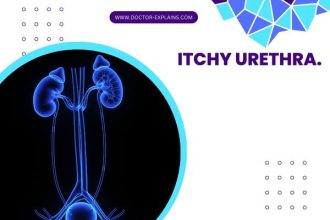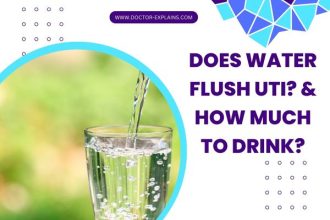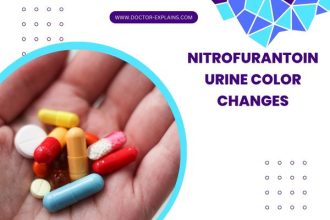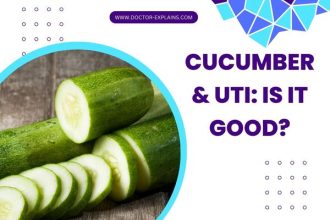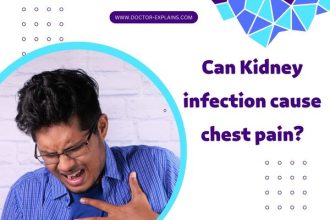UTI & stomach pain after eating, key facts:
If you’ve ever had a urinary tract infection (UTI), you know the discomfort it brings.
But can a UTI cause stomach pain after eating?
This is a question many people ask when dealing with these pesky infections.
In this article, we’ll explore the relationship between UTIs and stomach pain, as well as discuss other potential causes for discomfort after eating.
Here are some key facts from this article:
- This article explores the relationship between urinary tract infections (UTIs) and stomach pain after eating.
- UTI pain can arise from the bladder, urethra, or kidneys, and the location of the pain is typically in the pelvis, lower back, or in the flanks and upper back in the case of a kidney infection.
- Abdominal pain after eating is probably from gastrointestinal origin rather than urinary origin.
- Medications used to treat UTIs can cause stomach pain after eating as a side effect.
- Associated conditions such as IBS, gastritis, and gallbladder diseases can also cause stomach pain after eating if any of these conditions exist with UTI.
- The two forms of pain (pain arising from the kidney, ureter, or bladder VS pain from the gastrointestinal tract) can be differentiated based on some characteristics.
- The treatment of abdominal pain with UTI will depend on the underlying cause.
Does UTI Cause abdominal pain after eating?
Pain after eating is probably from gastrointestinal origin rather than urinary origin.
Abdominal pain after eating while you have UTI can be either a UTI or gastrointestinal pain. If you have stomach pain after eating, it is more likely to be of gastrointestinal origin rather than UTI pain.
UTI pain can arise from the bladder, urethra, or kidneys, and the location of the pain is typically in the pelvis, lower back, or in the flanks and upper back in the case of a kidney infection.
Patients may experience UTI pain during urination or constant bladder or lower back discomfort. It is essential to understand that urinary tract infection pain is unlikely to be caused by food.
However, UTIs can trigger gastrointestinal symptoms such as abdominal pain after meals, nausea, vomiting, diarrhea, and more. Possible explanations include:
A. UTI, especially the complicated type (pyelonephritis), can trigger stomach pain:
Kidney infection can commonly cause pain similar to that of gastrointestinal origin, and the pain may worsen after eating.
According to Uptodate.com, pyelonephritis pain can be in the form of:
- Flank pain (at one or both sides of the abdomen).
- Lower abdominal pain.
- Epigastric (upper abdominal pain).
- Nausea and vomiting.
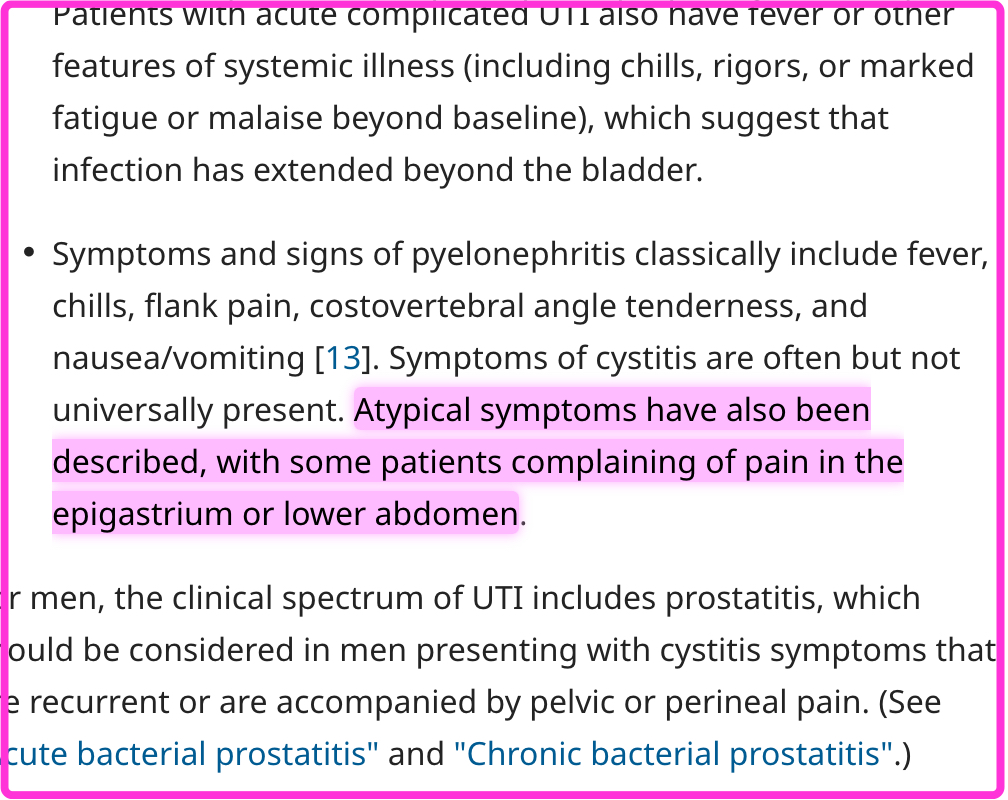
B. Medications:
Antibiotics and other medications used to treat UTIs commonly cause stomach pain after eating as a side effect. They can also cause other gastrointestinal side effects, such as nausea, vomiting, and diarrhea.
Several drugs are used to treat UTIs that can cause abdominal pain as a side effect. Some of these drugs include:
- Antibiotics: Antibiotics are a common treatment for UTIs. Some examples of antibiotics that can cause abdominal pain as a side effect include amoxicillin, ciprofloxacin, and nitrofurantoin.
- NSAIDs: Nonsteroidal anti-inflammatory drugs (NSAIDs) are often used to treat pain associated with UTIs. Some examples of NSAIDs that can cause abdominal pain as a side effect include ibuprofen and naproxen.
- Urinary analgesics: Urinary analgesics can help relieve pain associated with UTIs. Some examples of urinary analgesics that can cause abdominal pain as a side effect include phenazopyridine and methenamine.
It’s important to note that not everyone will experience abdominal pain as a side effect of these drugs, and other side effects may also be possible. If you are experiencing abdominal pain or any other side effect while taking medication for a UTI, you should talk to your doctor or healthcare provider.
C. Associated conditions that cause stomach pain with UTI.
Finally, associated conditions such as IBS, gastritis, and gallbladder diseases can also cause stomach pain after eating if any of these conditions exist with UTI.
It is important to consider all possible explanations for the symptoms that patients are experiencing.
Common conditions that may coexist with UTI and can cause stomach pain after eating include:
- IBS (Irritable Bowel Syndrome): A common disorder that affects the large intestine, causing symptoms such as abdominal cramping, bloating, constipation, and diarrhea.
- IBD (Inflammatory Bowel Disease): A chronic condition that causes inflammation in the digestive tract, leading to symptoms such as diarrhea, abdominal cramping, and blood in the stool.
- Gastritis: Inflammation of the stomach lining, which can cause symptoms such as nausea, vomiting, loss of appetite, and indigestion.
- Peptic Ulcer Diseases: Sores that develop in the lining of the stomach or small intestine, which can cause burning stomach pain, bloating, and heartburn.
- Gallbladder Diseases: Conditions that affect the gallbladder, which can cause symptoms such as nausea, vomiting, fever, and yellowing of the skin and eyes.
- Gastroenteritis: An infection of the digestive tract that can cause symptoms such as diarrhea, nausea, vomiting, and stomach cramps.
- Food Intolerance: Difficulty digesting certain foods, which can cause symptoms such as abdominal cramping, bloating, gas, and diarrhea.
Here’s a table summarizing the gastrointestinal diseases you mentioned, their characteristic symptoms, and pain location:
| Disease | Characteristic Symptoms | Pain Location |
|---|---|---|
| IBS (Irritable Bowel Syndrome) | Abdominal pain, bloating, gas, diarrhea, constipation, mucus in stool | Lower abdomen can vary |
| IBD (Inflammatory Bowel Disease) | Abdominal pain, cramping, diarrhea, weight loss, fatigue, blood in stool | Often lower right abdomen, can vary in Crohn’s; consistent in ulcerative colitis (lower left) |
| Gastritis | Upper abdominal pain, nausea, vomiting, indigestion, loss of appetite, bloating, weight loss | Upper abdomen, near the stomach |
| Peptic Ulcer Disease | Burning, gnawing pain, bloating, heartburn, nausea, vomiting, weight loss | Upper abdomen, near the stomach |
| Gallbladder Diseases (e.g., gallstones) | Severe, sudden right upper abdominal pain, back pain, right shoulder pain, nausea, vomiting, fever, jaundice | Upper right abdomen, under the ribs |
| Gastroenteritis | Diarrhea, nausea, vomiting, abdominal cramps, fever, headache, muscle aches | General abdominal pain |
| Food Intolerance | Bloating, gas, abdominal pain, diarrhea, nausea, vomiting, constipation, heartburn | Pain varies depending on the location of the intolerance reaction |
Keep in mind that this table provides general information, and individual symptoms may vary.
If you suspect that you or someone you know is experiencing any of these conditions, please consult a healthcare professional for a proper diagnosis and treatment plan.
Gastrointestinal pain Vs. UTI pain:
If you are experiencing stomach pain with UTI, It can be difficult to define the source of pain (whether from the urinary tract or from the gastrointestinal system).
The two forms of pain (pain arising from the kidney, ureter, or bladder VS pain from the gastrointestinal tract) can be differentiated based on some characteristics.
The table below summarizes the differences:
| Characteristic | Gastrointestinal Pain | Urinary Tract Pain |
|---|---|---|
| Pain Location | generalized or lower abdomen (intestinal pain), or upper abdomen (stomach, pancreas, gallbladder, or esophageal pain). | Lower abdomen, pelvis, lower back, or side |
| Related Symptoms | Bloating, gas, diarrhea, heartburn, or constipation. | Frequent urination, urgency, dysuria |
| Pain Character | Cramping (as IBS, gastroenteritis), sharp (as pancreatitis)., gnawing (such as gastritis), or burning. | Burning pain or discomfort (continuous) in the pelvic area, or flank pain. |
| Onset of Pain | Often related to food intake or bowel movements | Often related to urination |
| Pain Duration | Can be short-lived or chronic | It can be acute or chronic |
| Aggravating Factors | Certain foods, stress, or medication side effects. | Holding urine, sexual activity, urination. |
| Alleviating Factors | Antacids, dietary changes, bowel movements, or antispasmodics. | Emptying the bladder, antibiotics, or analgesics. |
| Associated Conditions | GERD, IBS, gastritis, food intolerance | UTI, kidney stones, interstitial cystitis |
Remember that this table provides a general overview of gastrointestinal and urinary tract pain characteristics, but individual experiences can vary.
Therefore, it’s important to consult a healthcare professional for a proper diagnosis and treatment plan if you’re experiencing persistent or severe pain.
Treatment of abdominal pain with UTI
If you experience stomach pain after eating, the treatment will depend on the underlying cause.
For instance:
- If the pain is related to a UTI, treating the UTI should resolve the gastrointestinal pain. In addition, antispasmodics, antacids, or PPIs may be recommended based on the type and location of the pain.
- If the pain is medication-related, stopping the medications that caused the pain, like antibiotics or analgesics, may help. However, it is crucial to consult a doctor before discontinuing any medication to avoid UTI persistence or relapse. Your doctor may prescribe other medications to ease the gastrointestinal side effects of UTI medications.
- Lastly, if the pain is associated with other diseases, such as gastritis, treatment will depend on the specific condition causing the pain. For example, your doctor may prescribe antacids, H2 blockers, or proton pump inhibitors to alleviate the pain.
